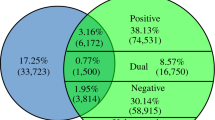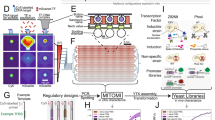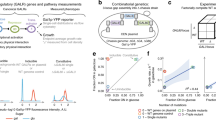Abstract
Although global analyses of transcription factor binding provide one view of potential transcriptional regulatory networks1,2, regulation also occurs at levels distinct from transcription factor binding3,4. Here, we use a genetic approach to identify targets of transcription factors in yeast and reconstruct a functional regulatory network. First, we profiled transcriptional responses in S. cerevisiae strains with individual deletions of 263 transcription factors. Then we used directed-weighted graph modeling and regulatory epistasis analysis to identify indirect regulatory relationships between these transcription factors, and from this we reconstructed a functional transcriptional regulatory network. The enrichment of promoter motifs and Gene Ontology annotations provide insight into the biological functions of the transcription factors.
This is a preview of subscription content, access via your institution
Access options
Subscribe to this journal
Receive 12 print issues and online access
$209.00 per year
only $17.42 per issue
Buy this article
- Purchase on Springer Link
- Instant access to full article PDF
Prices may be subject to local taxes which are calculated during checkout




Similar content being viewed by others
Accession codes
References
Lee, T.I. et al. Transcriptional regulatory networks in Saccharomyces cerevisiae. Science 298, 799–804 (2002).
Harbison, C.T. et al. Transcriptional regulatory code of a eukaryotic genome. Nature 431, 99–104 (2004).
Sekinger, E.A. & Gross, D.S. Silenced chromatin is permissive to activator binding and PIC recruitment. Cell 105, 403–414 (2001).
Radonjic, M. et al. Genome-wide analyses reveal RNA polymerase II located upstream of genes poised for rapid response upon S. cerevisiae stationary phase exit. Mol. Cell 18, 171–183 (2005).
Hughes, T.R. et al. Functional discovery via a compendium of expression profiles. Cell 102, 109–126 (2000).
Lieb, J.D., Liu, X., Botstein, D. & Brown, P.O. Promoter-specific binding of Rap1 revealed by genome-wide maps of protein-DNA association. Nat. Genet. 28, 327–334 (2001).
Hahn, J.S., Hu, Z., Thiele, D.J. & Iyer, V.R. Genome-wide analysis of the biology of stress responses through heat shock transcription factor. Mol. Cell. Biol. 24, 5249–5256 (2004).
Iyer, V.R. et al. Genomic binding sites of the yeast cell-cycle transcription factors SBF and MBF. Nature 409, 533–538 (2001).
Van Driessche, N. et al. Epistasis analysis with global transcriptional phenotypes. Nat. Genet. 37, 471–477 (2005).
Yeang, C.H. et al. Validation and refinement of gene-regulatory pathways on a network of physical interactions. Genome Biol. 6, R62 (2005).
Hartemink, A.J., Gifford, D.K., Jaakkola, T.S. & Young, R.A. Using graphical models and genomic expression data to statistically validate models of genetic regulatory networks. Pac. Symp. Biocomput. 422–433 (2001).
Mnaimneh, S. et al. Exploration of essential gene functions via titratable promoter alleles. Cell 118, 31–44 (2004).
Zhu, J. & Zhang, M.Q. SCPD: a promoter database of the yeast Saccharomyces cerevisiae. Bioinformatics 15, 607–611 (1999).
Chiang, D.Y., Moses, A.M., Kellis, M., Lander, E.S. & Eisen, M.B. Phylogenetically and spatially conserved word pairs associated with gene-expression changes in yeasts. Genome Biol. 4, R43 (2003).
Kellis, M., Patterson, N., Endrizzi, M., Birren, B. & Lander, E.S. Sequencing and comparison of yeast species to identify genes and regulatory elements. Nature 423, 241–254 (2003).
Roth, F.P., Hughes, J.D., Estep, P.W. & Church, G.M. Finding DNA regulatory motifs within unaligned noncoding sequences clustered by whole-genome mRNA quantitation. Nat. Biotechnol. 16, 939–945 (1998).
Bailey, T.L. & Elkan, C. Fitting a mixture model by expectation maximization to discover motifs in biopolymers. Proc. Int. Conf. Intell. Syst. Mol. Biol. 2, 28–36 (1994).
Liu, X.S., Brutlag, D.L. & Liu, J.S. An algorithm for finding protein-DNA binding sites with applications to chromatin-immunoprecipitation microarray experiments. Nat. Biotechnol. 20, 835–839 (2002).
Dilova, I., Aronova, S., Chen, J.C. & Powers, T. Tor signaling and nutrient-based signals converge on Mks1p phosphorylation to regulate expression of Rtg1.Rtg3p-dependent target genes. J. Biol. Chem. 279, 46527–46535 (2004).
Komeili, A., Wedaman, K.P., O'Shea, E.K. & Powers, T. Mechanism of metabolic control. Target of rapamycin signaling links nitrogen quality to the activity of the Rtg1 and Rtg3 transcription factors. J. Cell Biol. 151, 863–878 (2000).
Segal, E. et al. Module networks: identifying regulatory modules and their condition-specific regulators from gene expression data. Nat. Genet. 34, 166–176 (2003).
Simon, I. et al. Serial regulation of transcriptional regulators in the yeast cell cycle. Cell 106, 697–708 (2001).
Rosenfeld, N. & Alon, U. Response delays and the structure of transcription networks. J. Mol. Biol. 329, 645–654 (2003).
Hall, D.A. et al. Regulation of gene expression by a metabolic enzyme. Science 306, 482–484 (2004).
Sopko, R. et al. Mapping pathways and phenotypes by systematic gene overexpression. Mol. Cell 21, 319–330 (2006).
Winzeler, E.A. et al. Functional characterization of the S. cerevisiae genome by gene deletion and parallel analysis. Science 285, 901–906 (1999).
DeRisi, J.L., Iyer, V.R. & Brown, P.O. Exploring the metabolic and genetic control of gene expression on a genomic scale. Science 278, 680–686 (1997).
Killion, P.J., Sherlock, G. & Iyer, V.R. The Longhorn Array Database (LAD): an open-source, MIAME compliant implementation of the Stanford Microarray Database (SMD). BMC Bioinformatics 4, 32 (2003).
Eisen, M.B. & Brown, P.O. DNA arrays for analysis of gene expression. Methods Enzymol. 303, 179–205 (1999).
Acknowledgements
We thank members of the Iyer lab for help with microarray printing; T. Hughes, B. Ren, H. Dai and M. Robinson for advice on the error model; E. Marcotte for discussions and suggestions and J. Gu for statistical advice. This work was supported by grants from the US National Institutes of Health (NIH) and the US National Science Foundation (V.R.I.), by a training grant from the US National Institute on Alcohol Abuse and Alcoholism and by a University of Texas Continuing Fellowship (P.J.K.).
Author information
Authors and Affiliations
Contributions
Z.H., P.J.K. and V.R.I. designed the study, Z.H. did the microarray experiments, P.J.K. wrote the software, P.J.K. and Z.H. did the analysis and wrote the supplementary information and Z.H. and V.R.I. wrote the manuscript.
Note: Supplementary information is available on the Nature Genetics website.
Corresponding author
Ethics declarations
Competing interests
The authors declare no competing financial interests.
Supplementary information
Supplementary Fig. 1
Significance values of transcription factor targets. (PDF 108 kb)
Supplementary Table 1
Saccharomyces cerevisiae strain information. (PDF 117 kb)
Supplementary Table 2
ChIP-chip and TF knockout target overlap analysis. (PDF 50 kb)
Supplementary Table 3
Results of motif analysis. (XLS 107 kb)
Supplementary Table 4
Results of Gene Ontology analysis. (XLS 1128 kb)
Supplementary Table 5
RNA-binding proteins. (PDF 104 kb)
Supplementary Table 6
HSF1-based post-binding regulatory analysis results. (PDF 60 kb)
Rights and permissions
About this article
Cite this article
Hu, Z., Killion, P. & Iyer, V. Genetic reconstruction of a functional transcriptional regulatory network. Nat Genet 39, 683–687 (2007). https://doi.org/10.1038/ng2012
Received:
Accepted:
Published:
Issue Date:
DOI: https://doi.org/10.1038/ng2012
This article is cited by
-
Genome-wide promoter responses to CRISPR perturbations of regulators reveal regulatory networks in Escherichia coli
Nature Communications (2023)
-
BIONIC: biological network integration using convolutions
Nature Methods (2022)
-
Generating specificity in genome regulation through transcription factor sensitivity to chromatin
Nature Reviews Genetics (2022)
-
NetREX-CF integrates incomplete transcription factor data with gene expression to reconstruct gene regulatory networks
Communications Biology (2022)
-
A novel approach GRNTSTE to reconstruct gene regulatory interactions applied to a case study for rat pineal rhythm gene
Scientific Reports (2022)



